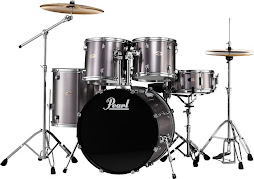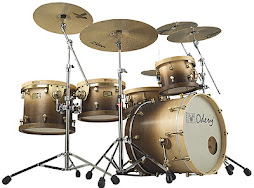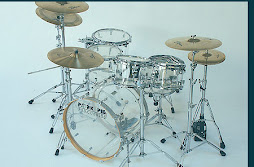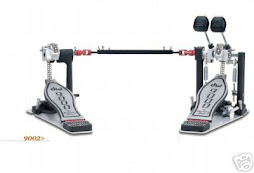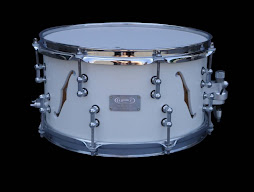The drum is said to be man's oldest musical percussion instrument.
It comes in all shapes and sizes. In the beginning it was small and simple in construction. Simply a piece of hide stretched over the end of a hollow log. Sticks or bones were used as beaters. It was found that by having drums of differing sizes, it was possible then to create a wide variety of tonal colours and contrast.
The drum was used in warfare, both as a means of giving signals to the soldiers and to create noise and drive fear into the enemy. Later the drum was use in a more musical sense, to create rhythm and dynamics for the Military Band. In peacetime, for the concert or the dance band. In the United Kingdom, with the formation of the Scottish Highland Regiments within the British Army in the mid 1800's, we were to see the formation of the Battalion pipe bands. Civilian pipe bands would also soon form. Toward the end of the 19th century, there would be competitions to assess which pipe band was the local champion. Again this would be followed by the District and National Championship. Eventually there would follow a competition titled, "The Worlds’ Pipe Band Championships".
When we think of pipe bands, we naturally think of Scotland. While the Great Highland Bagpipe has been a National musical instrument of Scotland, for the past 200 or more years Scots have migrated and settled in many countries throughout the world. There they have introduced their musical and traditional culture. This has been firmly established in countries such as, Canada, USA, Australia, New Zealand, Asia, just to name just a few.
It is interesting to note that some other European nations also have the bagpipe as part of their musical heritage and culture. Galicia in Spain, Brittany in France and also in a number of smaller European and North African countries have pipe bands.
The drum, particularly the snare drum, is termed "an instrument of indefinite pitch". That is to say, its' pitch can not be easily or accurately changed. How did drummers learn to play the drum? From the earliest times there was obviously some form of rudiments devised so that many drummers could play in unison. Of course there was then as there is today, only …"two drum sounds". They are …"The TAP and the ROLL”. But there are a great many variations and permutation patterns adding variety to these fundamentals.
In the early days drum rudiments and patterns or scores were taught by “Rote". It seems to be agreed historically that some form of Military snare drum score notation was in use at least in the 17th century. Patterns or regulated beatings would all have to be memorized. The drum was widely used in warfare in England and elsewhere to give signals for the soldiers to „Troop, Advance, March or Retreat etc. There was an English Royal Warrant issued in 1632, defining the drum sequence for the„"Voluntary before the March" and "The March". Following is an example of the type of drum score notation used.
These beatings would no doubt be typical of what was played by many military drummers of the time. The following is an example of part of "The March" shown in the Royal Warrant of 1632.
Later the drum would accompany the fife and so "Drum and Fife Bands" were born.
The Fife is a very old instrument, originally having only five sound holes. Later more holes and also keys were added to extent the range of the instrument.
From here drummers in Britain, North America and in many European countries such as France and Switzerland, seemed to adapt the standard "five line" musical staff to show drumming notation. The note head for the Snare Drum score was usually shown on the "C" space of the Treble Clef stave. The Bass Drum part when included was usually shown on the "F" space. It was not unusual to see the fingering for the snare drum beat patterns written below the notation as: RLRR LRLL RRL etc.
It would seem likely that in this era, that the fundamental rudiments, such as. The Single Tap, The Double Top, The Paradiddle and Roll, came to be standard elements. Later would come the Embellishments such as…The Flam and The Drag.
Potters of London and Aldershot, the famous English drum makers show these basic rudiments in later editions of their 19th century "Drum, Flute and Bugle Duty Tutor". (1886). However George B. Bruce published …"The Drummers and Fifers Guide", in New York, USA, in 1865. This Tutor defines drumming notation on the five line staff and shows a series of standard rudiments. From the Foreword, it indicates that this system had been established in the United States Military as early as 1812. It is claimed that Daniel D. Emmett wrote the first Drummers Manual for the United States Army in the 1820's. George Bruce and Dan Emmett also combined in 1861 to publish in New York, a "Drummers and Fifers Guide”.
In 1933, in Chicago USA, a group of drummers from all over the country came together to discus methods of teaching drumming. They all agreed on a set of "the thirteen Rudiments of Drumming". Later a further thirteen rudiments were added to this list to form the "Twenty six Essential Rudiments of Drumming". Soon the "National Association of Rudimental Drummers" was founded. In a very short time their world wide membership included a number of the leading pipe band drummers in Scotland. In 1962, the NARD published a book containing 150 solo score written by their members.
In Switzerland, particularly in the city of Basle, where snare drumming had evolved both in the Army and in civilian Drum and Fife bands (known as Cliques), for over four hundred years. Their drum scores were written in a series of "codes".
However in 1928, Dr Fritz Berger, a noted Basel Drummer, devised a new notation system for the drummer. This used the standard form of musical notation values etc. However only a "single line staff" was used. The Right hand tap or roll was shown by a note head… above the line and the Left hand tap or roll, with a note head below the line. He called it …"The Monolinear System of Notation".
Following are some examples of notation from these early publications:
- An example of drum score notation, Henry Potter Tutor, 1886.
- An example of drum score notation, Geo. Bruce's Tutor, 1865.
- An example from …Dr Fritz Berger’s Tutor 1928.
- An example from the …NARD Drum Solo collection. (1933) 1962.
But was happening in Scotland. Well we know that military pipe bands were introduced into the Highland Regiments in the mid 1800’s. Civilian pipe bands no doubt soon followed. Pipe Band competitions were introduced in a small way at local Highland Games. These Gatherings had been firmly established in Scotland since the early 18th century, at which Solo Piping competitions were firmly established.
The Cowal Highland Games in Dunoon is credited with being the oldest venue in Scotland where pipe band competitions have been continuously been held since early this century. In 1906 the Cowal Committee introduced competitions for Military pipe bands and in 1909 and with the _support of the late (Sir) Harry Lauder, competitions, for civilian pipe bands.
The late Drum Major John Seton, of the Glasgow Police and the 93rd Highlanders pipe bands, must be credited with introducing and the establishing pipe band drum notation in Scotland. He greatly assisted with others, of raising the standard of pipe band drumming. In 1924, John Seton combined with Pipe Major Willie Gray to publish the "Collection of Highland Bagpipe Music and Drum Settings". This book contained many drumming exercises and scores. Prior to this time, drummers in the pipe band would have relied heavily on Drum and Fife Tutor Books, to learn the fundamentals of drumming and musical notation. In the Seton Tutor the Snare Drum score notation is shown in the "C" space of the Treble Clef, with stems turned up wards. The Bass Drum part is shown in the "A" space with the stems turned down. Where only the Snare Drum notation only is shown, the note stems are turned downwards.
Following is an example:
In the 1920's it was the great teacher and innovator of pipe band drumming, Drum Major Jimmy Catherwood of the Dalzell Highland Pipe Band, who would lead and inspire pipe band drummers to develop new techniques. Jimmy's style and technique gave a much greater rhythmic and dynamic variety to the presentation.
Jimmy always took a very broad view of pipe band drumming seeking knowledge of other drumming and percussion idioms. He was also great on the "kit drums" and also tuned percussion. The Dalzell drum corps was at the top during the late 1920's and 30's. Jimmy introduced to Scottish drummers, the "Berger Monolinear system of Notation" to _Scotland in the early 1930's. After visiting Dr. Berger in Basle, Switzerland, Jimmy was impressed with this system and was convinced that it would be of great assistance to the pipe band drummer. But it was not till the late 1940's that this system became to be accepted by the pipe bands in Scotland. Today throughout the world, the monolinear system is the norm.
Drum Major Jimmy Catherwood's drum corps won many Worlds’ Championships in this era and many famous names passed through the corps. Gordon Jelly and Alex Duthart, just to name two.
Here is an example of part of a snare drum score written by Jimmy Catherwood in 1937 and played by one of his pupils, Jim Dalrymple in the SPBA Solo Championships in the following year.
In the City of Glasgow during the 1930's, there was another great drummer both playing in leading pipe bands and teaching many champion drum corps. This was Drum Major Alex D. Hamilton. He was also a professional orchestral drummer. He too had a wide perspective of drumming and percussion. In 1931, "A.D." published a book titled, "DRUM SCORES", A series of Advanced Beatings to Popular Pipe Tunes. The Snare, Tenor and Bass score are three braced staves. An example is shown below.
Jack Seton (the son of John) was Leading drummer of the Glasgow Police Pipe Band from the 30's till the late 1940's. He was followed by Alex McCormick, who was also a great drumming innovator and player.
In 1934 with Book 1. and in 1936, with Book 2, we saw two further interesting publications for the pipe band drummer. These were the "ARMY MANUAL" of Bagpipe Tunes and Drum Beatings for Massed Pipes and Drums. Initially published for the Scottish Highland Regiments within the British Army, these books filled a need for many young student drummers and Massed drum corps performances.
Drum Major A.D. Hamilton was later to become one of the founder members of the Scottish Pipe Band Association, "Pipe Band College". A respected Drumming Adjudicator of the SPBA, Alex was also a member of the SPBA College sub committee, that formulated the Association's first "Tutor and Text Book", Volume 1. Elementary level). This was first published in Glasgow in 1962.
After World War 2, there were three other interesting drumming publications. Firstly in Glasgow in 1951, was "The Gaelic Collection". Forty pages of advanced snare drum scores by Willie Paterson of the Clan Macrae Pipe Band and Alex McCormick of the Glasgow Police. Both former Worlds Champions. In 1953, we saw the "Edcath Collection". This contained compositions by leading Scottish pipers together with many snare drum scores by some of Scotland's then greatest exponents. Also early in the 1950's, Drum Major John Seton, now living in New Zealand, published his second tutor and collection of drum scores. This popular book was titled, "Fifty Years behind the Drum". Many scores included were played by winning drum corps at the Worlds Pipe Band Championships during the 1930's. Some "modern" rudiments were also included.
Since then there have been a number of excellent publications for the pipe band drummer. The Scottish Pipe Band Association in Glasgow published their "Tutor and Text Book", Volume 1 in 1962. A revised edition (Elementary) was published in 1978. This was followed by Book 2 (Intermediate Level) in 1971.
These tutor books were well received as they also contained the syllabus for the then various levels of SPBA College Examination Certification. They were widely welcomed and benefited drummers in many countries throughout the world.
In the early 1980's, the Music Board of the RSPBA agreed that both the piper and the drummer should extend their musical knowledge. Now "Ensemble" was the key word. For many years there had always been in pipe band competitions, a prize for the "best drum corps" at most competitions. Bands were now being encouraged to adopt a more "integrated approach" in their performance.
Within the pipe band movement in Northern Ireland, the Piping and Drumming School of the RSPBA (N.I.Branch) was of a similar opinion. This saw the publication by P/M Sam Baille in 1982, of the "Integrated Approach", together with Graded Lessons. The Music Board of the RSPBA also began compiling the first of three "Structured Learning" manuals. Volume 1 was published in 1987. This was followed by two further manuals in 1989 and 1990. The three covered the RSPBA College Examination Syllabus for the Certification requirement for the Elementary, Intermediate and Advanced levels for both pipers and drummers.
There have also been a number of other very interesting tutor books, audio tapes and collections published especially for the pipe band drummer in the 1980's and the 1990's.
These include the following:
1) The AFPBA (Australia) "Drumming Instruction Manual" 1983.
2) D/M Wilson Young, "Drum Tutor", Book 1 and Book 2, together with audio tapes. Glasgow.
3) "The Alex Duthart Book 1 ", Newmains, Scotland. 1987.
4) "The Alex Duthart Book 2 ". Newmains, Scotland. 1988.
5) The RNZPBA, New Zealand "Kickstart Drum Tutor".
6) Book 1 and Book 2, "Two Bar Phrases for Pipe Band Snare Drumming", by John Kerr, Toronto, Canada 1981.
7) "Learn to Play the Pipe Band Snare Drum", together with 2 x 60 audio tapes. A. Chatto, 1992.
There have also been a small number of limited edition publications by foremost leading drummers in Scotland and in other parts of the world.
So in all, today’s student of the art of pipe band drumming has a great number of reference publications and tutor books at their disposal. The older publications do give an insight into the progress and development of the art. There are many of these older groupings and rudiments which still do have their place in the "modern" pipe band drummer's repertoire.
This I hope, gives a very brief but concise over view of the progression and development of drumming rudiments, notation and many published works of particular interest to the student of pipe band drumming.
We can see that the same fundamental rudiments are required to be learnt by today’s student drummer as they were nearly four hundred years ago.
But modern technology has helped to "improve the sound" of the instrument allowing for faster, cleaner and more accurate beating. This of course still requires the student to apply great dedication and practise to perfect stick control, rhythm, expression and the subtle use of dynamics. For some, with good instruction, the road may be easier, but never the less even the most gifted must travel the same pathway to success.
It all must be a rhythmic accompaniment to enhance the melody. The feeling comes much from within, in addition to what is quite obvious to the listener or to the Drumming Adjudicator. Keep on with the practise and it will all come good in the end.
© ALLAN CHATTO. JANUARY 1996.
Saturday, May 31, 2008
Subscribe to:
Posts (Atom)


